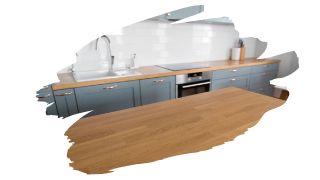Looking to protect your newly installed kitchen countertop, but not sure where to begin?
Well, one of the most frequent problems that can crop up with a wooden countertop is wood rot. But, you can prevent wood rot from marring your kitchen surface. And you can do this by sealing the countertop, preventing moisture from seeping into the wood.
So, what can you use to seal that countertop so that rot and decay don’t take hold?
Well, in this post, we explain why your typical wood finish isn’t enough to prevent water from damaging your countertop. You’ll also learn the difference between a microporous wood finish, and a truly waterproof finish — and why it matters when it comes to your kitchen sink.
And keep reading to discover which sealant combines the deep penetrating protection of Tung oil, with the waterproofing of polyurethane.

This post may contain affiliate links to products that we receive a commission for (at no additional cost to you). Learn more here.
Can You Really Have A Wooden Countertop With A Sink?
You can have a wooden kitchen sink countertop. But, only provided you do everything you can to properly seal it.
That seal will make all the difference between a fantastic looking countertop, or a rotting kitchen surface.
Related Post: Rotting Wood Around Your Sink? 3 Ways To Protect That Wooden Worktop
However, sealing wood that is right next to a sink is tricky. Especially as there is so much water vapor and splash-back happening around it.
So, What Do You Use To Seal A Sink With A Wooden Countertop?
You will need a waterproof sealant that’ll prevent all water, moisture, and even vapor, from getting through.
Now, this pretty much rules out most wood sealing options.
You see, most wood finishes aren’t 100% waterproof. Instead, they are what are called ‘microporous’ finishes.
Microporous finishes prevent large water droplets from soaking through. Yet, they do still allow water vapor to pass through them. So, moisture and vapor can still make its way past microporous finishes, such as Boiled Linseed oil and Tung oil.
Now, usually this is a great thing for wood. Especially since wood likes to ‘breathe’ and release moisture — especially with changes in humidity. And a microporous finish will allow wood to do just that.
However, to prevent splash-back from ruining your countertop, you need a truly waterproofing sealant. And a waterproof sealant is one that will prevent all moisture and vapor from getting in or out of wood.
Which is why waterproof sealants, such as polyurethane and silicone, are going to be your best bet at safeguarding your countertop.
Related Post: Why Does Wood Feel Rough After Applying Polyurethane?
OK Great! So What Is The Best Sealer For A Wooden Countertop?
Ideally, you’ll want to use something that blends a penetrating oil finish with a waterproofing sealant solution. This will allow you to protect that wooden countertop from the inside out.
Which is why Waterlox is such a fantastic option for sealing a countertop, and preventing water from ruining your kitchen.
You see, Waterlox Original Sealer Finish blends Tung oil with Urethane. Urethane is the key ingredient found in polyurethane sealants.
So, this penetrating oil + urethane combination means that this sealant can soak right down into wood. All while forming a watertight seal around it.
Waterlox Original Sealer Finish is a base sealant coat, so you’ll only need to apply a couple thin coats of it. It will then need to be top coated with Waterlox Urethane Finish. This combination will then form a complete waterproof seal.
Waterlox is also a food safe wood finish — which is key for any wood finish used in a kitchen area. And what this means is that, provided it’s wholly dried and cured, it is safe for indirect contact with food.
It is not, however, a food grade wood finish. Which means that it is not suitable for direct contact with food. So, do not use this finish to seal a food prepping surface, such as a butcher block countertop.
Wait…Doesn’t Food Safe Pretty Much Mean It’s Food Grade?
Food safe wood finishes are safe for indirect contact with food. So, these finishes are fine to coat onto surfaces such as kitchen countertops, and dining tables.
And once a food safe wood finish has dried and cured, it no longer risks ‘leeching’ into nearby food.
However, food grade wood finishes are safe for direct contact with food. These finishes are perfect for coating onto food prep surfaces such as cutting boards and butcher blocks.
Food grade wood finishes are non-toxic, and can even be consumed without causing any harm to us. Wood finishes such as pure 100% food grade mineral oil, for example, is a food grade wood finish.
Related Post: Walnut Oil Vs Mineral Oil: Which One’s Better For Your Cutting Board?
And What Is The Difference Between A Dry And A Cured Wood Finish?
A dry wood finish goes through evaporation, turning it from a liquid into a solid (yet often still soft) film. However, a dry wood finish can continue to release fumes (also known as VOCs ‘Volatile Organic Compounds’).
But, a cured wood finish goes through a chemical process that completely changes it into its final wholly solidified form. Once cured, a wood finish will no longer release VOC’s into the air.
To Wrap Up, Here Are The 3 Key Takeaways From This Post…
- 1). A wooden countertop, (situated at a nearby kitchen sink), needs to be sealed with a waterproof sealant.
- 2). Only sealants that are not microporous, (such as polyurethane or silicon), are waterproof enough to prevent vapor from getting through.
- 3). Ideally, use a penetrating waterproof sealant on your kitchen sink countertop. This will help protect wood from the inside out.


![A Quick Beginners Guide To Rubberwood Vs Birch Wood [For A Butcher Block Countertop] rubberwood vs birch countertop](https://www.thewoodworkplace.com/wp-content/uploads/2022/11/Banner-525-150x150.jpg)
